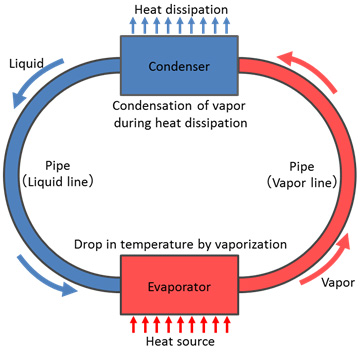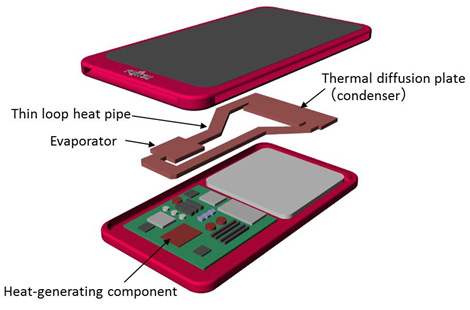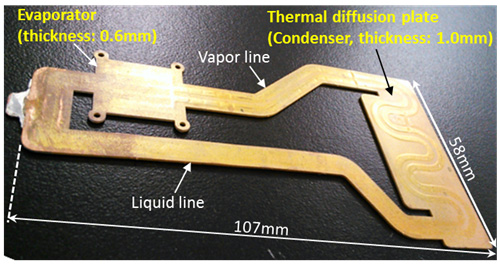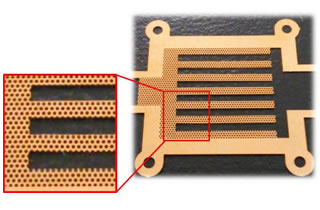x
- More +
Fujitsu Develops World’s First Thin Cooling Device for Compact Electronics – Mar 16, 2015– Kawasaki, Japan (Techreleased) – Fujitsu today announced the development of the world’s first thin cooling device designed for small, thin electronic devices. Smartphones, tablets, and other similar mobile devices are increasingly multifunctional and fast. These spec improvements, however, have increased heat generated […]

Fujitsu Develops World’s First Thin Cooling Device for Compact Electronics – Mar 16, 2015– Kawasaki, Japan (Techreleased) – Fujitsu today announced the development of the world’s first thin cooling device designed for small, thin electronic devices.
Smartphones, tablets, and other similar mobile devices are increasingly multifunctional and fast. These spec improvements, however, have increased heat generated from internal components, and the overheating of localized parts in devices has become problematic. Fujitsu has developed a thin loop heat pipe, less than one millimeter thick, to solve this problem. This new device was developed using technologies for stacking metal sheets. It is capable of transferring approximately five times more heat than current thin heat pipes.
This technology will make it possible for CPUs and other heat-generating components to run cooler and to avoid concentrated hot-spots inside devices.
Details of this technology are being presented at the Semiconductor Thermal Measurement, Modeling and Management Symposium 31 (SEMI-THERM 31), opening March 15 in San Jose, California.
For mobile devices such as smartphones, tablets, and notebook computers, communications and data-processing speeds have accelerated, multi-functionality, such as with cameras, has advanced, and the devices themselves are becoming smaller and slimmer. The increased functions and decreased size of these devices has led to extremely dense packages, where the heat generated by each square unit has increased. Heat generated within the device can also raise surface temperature. In order to provide customers with a more comfortable mobile device, it is necessary to reduce concentrations of heat within devices.
With portable devices that cannot accommodate blower fans or water-cooling pumps, the conventional approach has been to install sheets of metal or graphite with relatively high thermal conductivity to transfer heat away from heat-generating components, thereby avoiding internal hot-spots. With increased amounts of generated heat, however, the thermal conductive properties of these materials alone are no longer sufficient in transferring heat.
Fujitsu has developed the world’s first loop heat pipe less than 1 millimeter thick that can be added to small, thin electronics.
A loop heat pipe is a heat-transfer device that consists of an evaporator that absorbs heat from the heat source and a condenser that dissipates that heat away, with the two components connected by pipes into a loop (Figure 1). A working fluid is encapsulated inside this closed loop as a coolant. The heat from the heat source evaporates the coolant, and the energy that goes into evaporating the coolant is taken away from the heat source, lowering its temperature. It is based off of the same principle used when sprinkling water on pavement to reduce heat.
The thin loop heat pipe that Fujitsu has developed can be installed on a heat-generating component, such as a CPU, in an electronic device so that the heat generated by the component is carried to a relatively cool spot inside the device to diffuse the heat (Figure 2).
Features of the technology are as follows:
Heat transfer using a loop heat pipe is based on the same sort of capillary action that absorbs water in fibers, sponges, and plants. The evaporator contains a porous structure, with the numerous holes driving the fluid with capillary action. To achieve this action, Fujitsu stacked together copper sheets to develop a structure containing minuscule pores. The pattern of holes etched into the sheets is such that the holes of each layer are slightly offset from the adjacent layers. When these sheets are stacked, capillary action is created that causes the fluid to circulate. In addition, by separating the vapor phase and liquid phase, there are two flows of the working fluid within the stacked structure, which enables efficient heat transfer. Furthermore, because the liquid line that returns fluid to the evaporator operates on capillary action, enabling it to stably transfer heat regardless of the device’s orientation, this technology can now be applied to mobile devices.
This loop heat pipe uses copper sheets that are only 0.1 mm thick, with two surface sheets and four inner-layer sheets, for a total of six sheets. The previous, approximately 10 mm thick evaporator of the loop heat pipe can now be reduced to 0.6 mm, enabling a heat-transfer device to be equipped to compact mobile devices.
 Figure 1: Configuration of a loop heat pipe
Figure 1: Configuration of a loop heat pipe
 Figure 2: New thermal management concept for a smartphone equipped with a loop heat pipe
Figure 2: New thermal management concept for a smartphone equipped with a loop heat pipe
 Figure 3: Prototype model of a thin loop heat pipe
Figure 3: Prototype model of a thin loop heat pipe
 Figure 4: Etched pattern of the evaporator section in an inner layer sheet
Figure 4: Etched pattern of the evaporator section in an inner layer sheet
(The evaporator consists of a stack of four copper sheets with a slightly staggered position of holes.)
Compared to the previous thin heat pipes and material of highly thermal conductive sheets, this new device allows for approximately five times greater heat transfer. This new technology will allow CPUs and other parts to function at low temperatures while preventing heat concentration within localized areas, thus introducing new possibilities for cooling small electronic devices.
Because this loop heat pipe uses the heat from the heat source to power thermal transfer, without using an external pump or other energy source, it does not increase the overall energy consumption of the device in order to diffuse heat, allowing for convenient and comfortable usage of electronic devices.
Fujitsu will develop design and cost-saving technologies for mobile devices equipped with the thin loop heat pipe, with the aim of introducing a practical implementation during fiscal 2017. In addition, this technology allows for freedom when designing mobile devices because the patterning is performed by etching metal sheets, meaning that the pipe layout and the amount of heat transferred can be customized for each device. The company is examining potential applications beyond mobile devices, such as to communications infrastructure, medical equipment, and wearable devices.